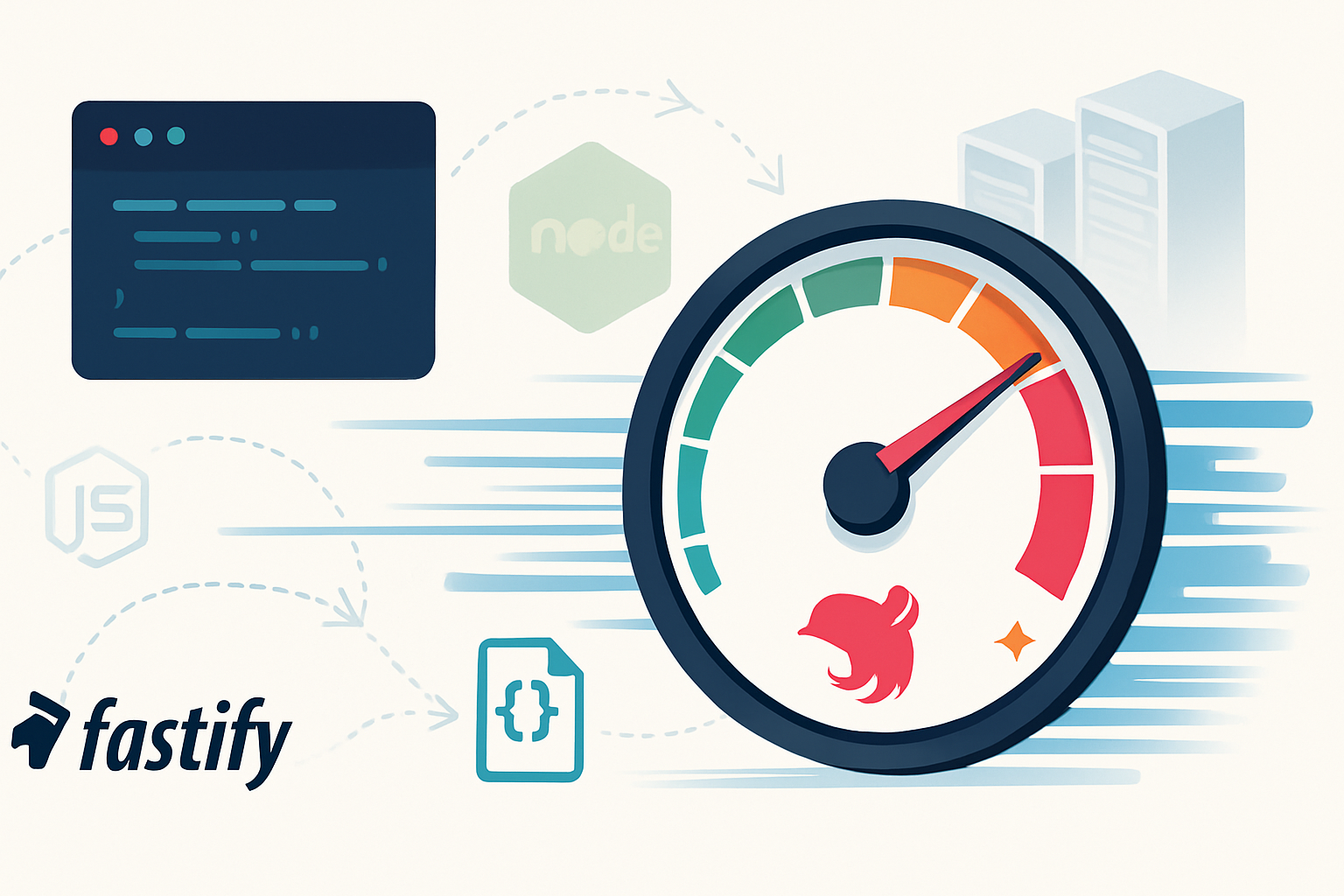· frameworks · 6 min read
Mastering Hapi.js: 10 Tips to Boost Your API Performance
Learn 10 practical, high-impact techniques to make your Hapi.js APIs faster, leaner, and more scalable. Covers Catbox caching, response ETags, streaming, database patterns, validation tuning, plugin design, metrics, clustering, and avoiding event-loop blocking.

Outcome: faster responses, lower latency, and an API that scales predictably. Read on and you’ll walk away with ten concrete changes you can apply to a Hapi.js service today to get measurable gains.
Why focus on Hapi.js performance now?
Hapi is a powerful framework with a rich plugin system. That power can hide inefficiencies. A few targeted improvements often yield large wins - faster response times, fewer DB calls, and less CPU overhead on each request. Below are 10 practical tips, with examples and links, so you can make confident changes without guesswork.
Tip 1 - Use Catbox and server.method caching for hot data
Outcome: reduce repeated work and DB hits for identical requests.
Hapi’s built-in caching layer (Catbox) is battle-tested. Use server.method() to wrap expensive functions and let Hapi handle cache TTL, keys, and stale refreshes.
Example:
// register once
server.method(
'getUserById',
async id => {
return db.users.findById(id);
},
{
cache: {
expiresIn: 60 * 1000, // 1 minute
generateTimeout: 2000,
},
}
);
// later in a route
const user = await server.methods.getUserById(request.params.id);For multi-instance fleets, use a shared Catbox store like Redis (catbox-redis) so caches are consistent across nodes. See Catbox docs: https://hapi.dev/module/catbox/ .
Tip 2 - Cache responses and use conditional requests (ETag / Last-Modified)
Outcome: transfer less data, speed up client perceived performance.
If responses are cacheable, add proper cache-control headers and ETags. You can compute ETags server-side or use a plugin to make this easier. When the client sends If-None-Match, return 304 Not Modified and avoid serializing the full payload.
Plugins and helpers can automate ETag handling; search for community plugins or implement a simple hash of the payload and send it in etag header.
Reference: eTag patterns and HTTP caching best practices.
Tip 3 - Stream large payloads and enable compression
Outcome: avoid blocking memory and reduce bandwidth.
For large files or results, stream data rather than building huge in-memory strings. Use Node streams for DB query results or file responses. Also enable gzip/deflate for responses when appropriate.
Example for streaming a file (using @hapi/inert for static content):
// serve large file efficiently
return h.file('/path/to/large.bin');For response bodies generated dynamically, pipe streams and set Content-Encoding with a compression transform (zlib), or use a community compression plugin.
Tip 4 - Optimize database access: pooling, projection, batching, pagination
Outcome: fewer and faster DB calls.
Common anti-patterns: N+1 queries, fetching full rows when you only need a few fields, unbounded queries returning massive sets.
Practices:
- Use connection pooling (most DB clients provide this: e.g.,
pg.Pool). - Use projection to request only needed columns.
- Batch related queries or use joins when appropriate.
- Implement cursor-based pagination or limit/offset carefully for large datasets.
Measure query time and tune indexes on the DB side - often the biggest wins are there.
Tip 5 - Tune payload parsing and validation
Outcome: reduce CPU per-request and reject bad requests early.
Hapi parses and validates payloads (and route params) automatically, typically with Joi. But validation can be heavy if schemas are large or use expensive patterns (complex regex, transforms).
Recommendations:
- Set
payload: { maxBytes: ... }on routes to avoid huge uploads. - Keep Joi schemas as narrow as possible, and avoid unnecessary custom validation functions.
- Use
abortEarly: trueto fail fast where appropriate.
Example:
server.route({
method: 'POST',
path: '/items',
options: {
payload: { maxBytes: 1048576 }, // 1MB
validate: { payload: itemSchema }
},
handler: ...
})Docs: Joi validation patterns (https://joi.dev/).
Tip 6 - Keep plugins lean and defer heavy startup work
Outcome: faster restarts and a more responsive server under load.
Hapi’s plugin architecture is powerful; use it. But don’t do heavy, synchronous work in plugin register functions. If a plugin needs expensive initialization (caching warm-up, large precomputations), do it asynchronously and preferably outside the request path, maybe in onPreStart or as a background task.
Also avoid global singletons that serialize access to resources; design plugins to be stateless where possible.
Reference: Hapi plugin guide: https://hapi.dev/tutorials/plugins/
Tip 7 - Prefer route-level options to global middleware when possible
Outcome: avoid unnecessary work per request.
Hapi does not use Express-style middleware; it uses route lifecycle and plugins. Avoid registering heavy global extensions or lifecycle events that run for every request. Instead, scope logic to the routes that need it (route-specific auth, validation, transforms). That limits CPU and memory usage for requests that don’t need the extra work.
Tip 8 - Log smartly and measure with metrics
Outcome: find real bottlenecks instead of guessing.
Use structured, low-overhead logging (e.g., hapi-pino) and capture request durations, DB timings, and error rates. Export metrics to Prometheus or another observability backend and create dashboards and alerts for 95th/99th percentile latencies.
Consider hapi-pino for fast logs: https://github.com/pinojs/hapi-pino
Example metrics to collect:
- Request duration percentiles
- DB query duration percentiles
- Event loop lag
- Error rates by route
Tip 9 - Scale horizontally, and use a shared cache when needed
Outcome: predictable capacity growth and reduced cache inconsistency.
When a single Node process isn’t enough, run multiple instances behind a load balancer or a process manager like PM2. If you rely on in-memory caches, switch to a shared cache (Redis) to make sure all instances see the same cached values. Catbox has providers for shared backends such as Redis: https://hapi.dev/module/catbox-redis/
Also consider a CDN in front of public endpoints to offload traffic.
Tip 10 - Avoid blocking the event loop; offload CPU work
Outcome: keep request latency low and consistent.
Node’s single-threaded event loop means CPU-heavy tasks will stall all requests. Identify CPU hotspots (JSON serialization of enormous objects, complex data transforms, crypto operations) and move them to worker threads or external services.
Options:
- Use Node’s
worker_threadsfor CPU-intensive work. - Move heavy batch processing to background jobs (Redis queues, Bull, etc.).
- Pre-compute or cache heavy transforms if possible.
Node worker threads docs: https://nodejs.org/api/worker_threads.html
How to prioritize these tips
- Measure first. Use lightweight metrics and time a handful of routes.
- Apply the low-risk, high-reward changes: server.method caching, DB query optimization, and payload limits.
- Add observability and iterate: logs, request traces, percentiles.
- Scale and distribute caches only after you’ve reduced per-request cost.
A few small changes (cache frequently-read results, stream large bodies, and avoid blocking the event loop) usually produce the largest drop in latency.
Quick checklist to run now
- Add
server.method()caching for expensive lookups - Limit payload sizes and simplify Joi schemas
- Stream files and enable compression
- Profile DB queries; add indexes and projection
- Add structured logs and request metrics
Make these changes, measure again, and you’ll find the next bottleneck. Repeat.
Final thought: Hapi gives you control. Use it to keep per-request work small, cache wisely, and observe relentlessly. Do those three well and your API will perform - even as traffic grows.



